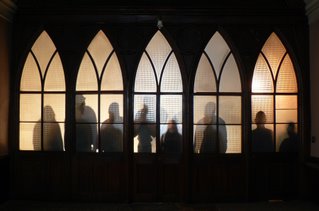05/13/07
Exhibit chugs through steamboat history
By Justin C. Maiman
In front of a crowd anticipating an explosion, Robert Fulton's North River Steamboat of Clermont, set off on Aug. 17, 1807, for Albany from Greenwich Village. Nothing blew up, but the 5 mph steamboat trip proved to be a milestone journey, not just on the Hudson River, but for transportation around the country.
Fulton and his partner Robert Livingston didn't invent the paddle-wheel boat or the steam engine, but they ushered in the steamboat as a popular form of passenger travel, and a faster and cheaper way to transport goods.
"Full Steam Ahead: Robert Fulton and the Age of Steamboats" at the Albany Institute of History & Art offers a glimpse of the 19th-century sights and sounds on the Hudson River.
"He was no fool," said Ruth Greene-McNally, curator of the new exhibit. "Livingston had already secured a monopoly for navigating all vessels propelled by steam on New York state waterways. And after meeting in Paris, he encouraged Robert Fulton to turn his attention to the steamboat."
The exhibit anticipates the upcoming 200th anniversary of the Fulton voyage. Celebrations begin Aug. 17, the day Fulton set out from New York City hoping to become a commercial success, after several of his inventions and designs for steam warships and a submarine never took off in Europe and America.
In little more than 32 hours, the Clermont made it to Albany, where another crowd awaited, also wary of an explosion. Local sloop captains were not pleased with Fulton's innovation. His steamboat was even rammed by a jealous captain.
"There was mixed reaction because sloop captains were being phased out of business and also people were very fearful," said Greene-McNally.
Despite the historic voyage, the Clermont returned to New York City almost empty. Two passengers, a pair of adventurous Frenchmen, went along, paying $3 each.
M. Michaux wrote about his ride in a letter home: "So great was the fear of the explosion of the boiler that no one, except my companion and myself, dared to take passage in it for New York. From every point on the river whence the boat announced by the smoke of its chimney ... we saw the inhabitants collect; they waved their handkerchiefs and hurrahod for Fulton."
"The ride on the Hudson would have been choppy and very loud," according to Travis Bowman, steamboat aficionado and curator of collections at the Clermont State Historic Site. "But Fulton knew he could make it work because of extensive testing. It wasn't until steamboat racing that you saw a lot of explosions."
A national change
After the Clermont, America was changed forever.
Before the steamboat, the 150-mile river voyage was at least a three-day journey by sloop. By stagecoach, the Albany-New York City journey could take weeks. Within weeks of the maiden voyage, the steamboat was making regular trips up and down the Hudson.
Hundreds of passengers bought tickets, paying $7 each way between Albany and New York City. Initially, only wealthy citizens were able to afford this passage.
The service was so popular copycat boats and captains soon followed. Each was met with a lawsuit from Fulton and Livingston, and the two successfully protected their steamboat monopoly for almost two decades.
The larger story
The Albany Institute exhibit fills two rooms and focuses first on Fulton and Livingston, and then segues into a much larger story, that of the golden age of the steamboat.
That 50-year span was filled with deadly races and wrecks, the rise of the robber barons and posh three-deck floating palaces on the Hudson.
These stories are told through drawings, paintings, letters, models and artifacts, most of which were already part of the institute's extensive collection.
Tammis Groft, deputy director for collections and exhibitions at the Albany Institute, called the Fulton show a prelude to the upcoming Hudson 400, celebrating Henry Hudson's exploration of the river. She said the research is paving the way for the larger exhibition in 2009.
Art exhibit
"FULL STEAM AHEAD: Robert Fulton and the Age of Steamboats"
What: Exhibit commemorating the 200th anniversary of Fulton's first steamboat voyage of the Clermont in 1807 from New York City to Albany.
Where: Albany Institute of History & Art, 125 Washington Ave., Albany
When: through December
Gallery hours: 10 a.m.- 5 p.m. Wednesday-Saturday; noon-5 p.m. Sunday; open Tuesdays to preregisterd groups; closed Mondays and major holidays
Admission: $8, adults; $6, seniors/students; $4, ages 6-12; ages 5 and younger, admitted free
Info: 463-4478; http://www.albanyinstitute.org/
FACTS
Fulton's steamboat the Clermont sparked a transportation revolution when it set sail for Albany from New York City in 1807. Some details about the ship and its Hudson River voyage follow.
Travel time: New York City to Albany: 32 hours
Speed: just under 5 mph
Powered by: Two paddle-wheels, steam engine
Fuel: Wood


